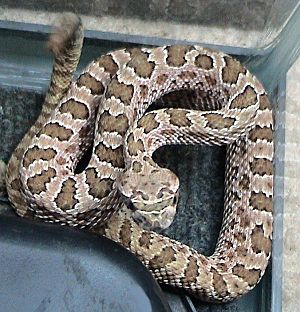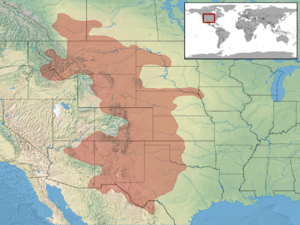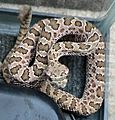Prairie rattlesnake facts for kids
Quick facts for kids Prairie rattlesnake |
|
|---|---|
 |
|
| Hopi rattlesnake, C. v. nuntius | |
| Conservation status | |
| Scientific classification | |
| Genus: |
Crotalus
|
| Species: |
viridis
|
 |
|
| Synonyms | |
|
|
The Crotalus viridis, often called the prairie rattlesnake, is a type of venomous snake. It belongs to the group of snakes known as pit vipers. These snakes are known for their heat-sensing pits on their faces.
Currently, scientists recognize one main type of prairie rattlesnake. There is also one special kind, called a subspecies.
Contents
What Prairie Rattlesnakes Look Like
Prairie rattlesnakes usually grow to be about 100 centimeters (3.3 feet) long. That's about the length of a baseball bat! Some in Montana can even reach 120 centimeters (3.9 feet).
The longest one ever found was 151.5 centimeters (almost 5 feet) long. They are usually light brown. They also have darker brown patches on their bodies.
What Prairie Rattlesnakes Eat
Prairie rattlesnakes mostly eat small mammals. Their favorite foods include ground squirrels, mice, rats, small rabbits, and prairie dogs.
Young prairie rattlesnakes have a slightly different diet. They prefer to eat amphibians, like frogs, and small reptiles.
Reproduction
Prairie rattlesnakes are viviparous. This means they give birth to live young, instead of laying eggs. A mother rattlesnake can have anywhere from 3 to 25 babies at one time.
The young snakes are usually born between August and October.
How Prairie Rattlesnakes Behave
Prairie rattlesnakes change their activity based on the weather. When it's cool, they are diurnal, meaning they are active during the day. When it's hot, they become nocturnal, meaning they are active at night.
They have a very strong venom. However, they only use it if they feel attacked or threatened. Like other rattlesnakes, they shake their tail. This makes a rattling sound that warns enemies to stay away.
Other Names for the Prairie Rattlesnake
The prairie rattlesnake has many other common names. Some people call it the "Western Rattlesnake" or the "Plains Rattlesnake." Other names include the "Black Rattler," the "Confluent Rattlesnake," and the "Missouri Rattlesnake." It's also known as the "Spotted Rattlesnake" and the "Western Pacific Rattlesnake."
Where Prairie Rattlesnakes Live
These snakes live in many places across North America. You can find them in southwestern Canada, the United States of America, and northern Mexico.
In Canada, they live in Alberta and Saskatchewan. In the United States, they are found in eastern Oregon, eastern Washington, southern Idaho, Montana, North Dakota, South Dakota, Wyoming, Nebraska, Colorado, Kansas, Oklahoma, Texas, New Mexico, and eastern Arizona. In Mexico, they live in northern Coahuila and northwestern Chihuahua.
Prairie Rattlesnake Subspecies
Besides the main type, Crotalus Viridis Viridis, there is one recognized subspecies. This special type is called the "Hopi Rattlesnake" (Crotalus Viridis Nuntius).
The Hopi rattlesnake lives in northeastern and north-central Arizona. It can also be found in New Mexico.
Images for kids
See also
 In Spanish: Crotalus viridis para niños
In Spanish: Crotalus viridis para niños






